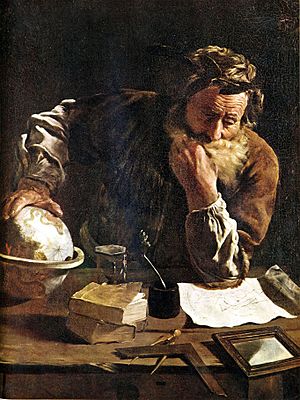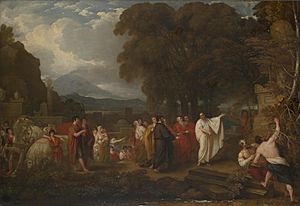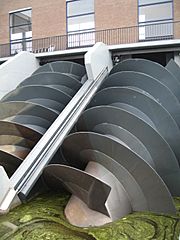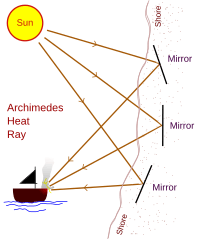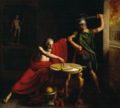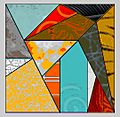Archimedes facts for kids
Archimedes (287 BC–212 BC) was a Greek scientist. He was an inventor, an astronomer, and a mathematician. He was born in the town of Syracuse in Sicily.
Contents
Biography
Archimedes was born c. 287 BC in the seaport city of Syracuse, Sicily. Syracuse was a rich Greek city. His father was Phidias, an astronomer, and he may have been in the family of a king of Syracuse. When Archimedes was about ten years old, he left Syracuse to study in Alexandria, Egypt. He was in the school of Euclid, a famous mathematician. Not much is known about the personal life of Archimedes, for example, whether he was married or if he had children. He died during a Roman invasion.
The standard versions of Archimedes' life were written long after his death by Greek and Roman historians. The earliest reference to Archimedes occurs in The Histories by Polybius (c. 200–118 BC), written about 70 years after his death. It sheds little light on Archimedes as a person, and focuses on the war machines that he is said to have built in order to defend the city from the Romans. Polybius remarks how, during the Second Punic War, Syracuse switched allegiances from Rome to Carthage, resulting in a military campaign under the command of Marcus Claudius Marcellus and Appius Claudius Pulcher, who besieged the city from 213 to 212 BC. He notes that the Romans underestimated Syracuse's defenses, and mentions several machines Archimedes designed, including improved catapults, crane-like machines that could be swung around in an arc, and other stone-throwers. Although the Romans ultimately captured the city, they suffered considerable losses due to Archimedes' inventiveness.
Cicero (106–43 BC) mentions Archimedes in some of his works. While serving as a quaestor in Sicily, Cicero found what was presumed to be Archimedes' tomb near the Agrigentine gate in Syracuse, in a neglected condition and overgrown with bushes. Cicero had the tomb cleaned up and was able to see the carving and read some of the verses that had been added as an inscription. The tomb carried a sculpture illustrating Archimedes' favorite mathematical proof, that the volume and surface area of the sphere are two-thirds that of an enclosing cylinder including its bases. He also mentions that Marcellus brought to Rome two planetariums Archimedes built. The Roman historian Livy (59 BC–17 AD) retells Polybius' story of the capture of Syracuse and Archimedes' role in it.
Plutarch (45–119 AD) wrote in his Parallel Lives that Archimedes was related to King Hiero II, the ruler of Syracuse. He also provides at least two accounts on how Archimedes died after the city was taken. According to the most popular account, Archimedes was contemplating a mathematical diagram when the city was captured. A Roman soldier commanded him to come and meet Marcellus, but he declined, saying that he had to finish working on the problem. This enraged the soldier, who killed Archimedes with his sword. Another story has Archimedes carrying mathematical instruments before being killed because a soldier thought they were valuable items. Marcellus was reportedly angered by Archimedes' death, as he considered him a valuable scientific asset (he called Archimedes "a geometrical Briareus") and had ordered that he should not be harmed.
The last words attributed to Archimedes are "Do not disturb my circles" (Latin, "Noli turbare circulos meos"; Katharevousa Greek, "μὴ μου τοὺς κύκλους τάραττε"), a reference to the mathematical drawing that he was supposedly studying when disturbed by the Roman soldier. There is no reliable evidence that Archimedes uttered these words and they do not appear in Plutarch's account.
Spherical geometry
On the Sphere and Cylinder is a work that was published by Archimedes in two volumes in about 225 BC. On the sphere, he showed that the surface area is four times the area of its great circle. In modern terms, this means that the surface area is equal to:
 .
.
The surface area of a cylinder is equal to:
The volume of the cylinder is:
The volume of the contained ball is two-thirds the volume of a "circumscribed" cylinder. meaning that the volume is
A sculpted sphere and cylinder were placed on the tomb of Archimedes at his request.
Archimedes the scientist
Archimedes is also well known for being the first person to understand statics, which is a part of applied mathematics. It has to do with loads that do not move, for example in buildings or bridges. He also understood and wrote about what happens when things float in liquids, which is called buoyancy.
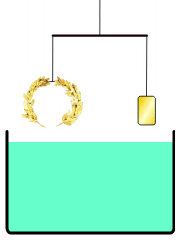
Archimedes' principle

Archimedes' principle: the weight of water displaced by an object equals the amount of buoyancy it gets. It has practical uses. It can be used to measure the density of an object, and hence whether or not it is made of gold.
The story of the golden crown does not appear in the surviving works of Archimedes. Archimedes may have got a solution known in hydrostatics as Archimedes' principle, which he describes in his treatise On Floating Bodies. This principle states that a body immersed in a fluid experiences a buoyant force equal to the weight of the fluid it displaces. Using this principle, it would have been possible to compare the density of the golden crown to that of solid gold by balancing the crown on a scale with a gold reference sample, then immersing the apparatus in water. The difference in density between the two samples would cause the scale to tip accordingly. Galileo considered it "probable that this method is the same that Archimedes followed, since, besides being very accurate, it is based on demonstrations found by Archimedes himself".
Archimedes, the inventor and engineer
Archimedes is also famous as an inventor because he made new tools and machines. For example, he made a machine to lift water that could be used by farmers to bring water to their crops. This is called Archimedes' screw.
Archimedes probably also invented a machine to measure distance, an odometer. A cart was built with wheels that turned four hundred times in one mile. A pin on the wheel would hit a 400-tooth gear, so it turned once for every mile. This gear would then make a small stone fall into a cup. At the end of a journey one could count the number of stones in the cup to find the distance.
Archimedes also made a system which one person could pull a large ship with just one rope. This was called the compound pulley. This is an important machine even today, as it helps people in everyday life, although the versions we now use are much more complicated. They still work by the same principle, though.
Archimedes at war
Archimedes also invented or made many machines used in war, for example he made better catapults. This was during the Punic Wars, which were between Rome in what is now Italy and the city of Carthage in what is now North Africa. For many years he helped stop the Roman army from attacking Syracuse, his city. One war machine was called the "claw of Archimedes", or the "iron hand". It was used to defend the city from attacks by ships. Ancient writers said that it was a kind of crane with a hook that lifted ships out of the water and caused their destruction.
Another story about Archimedes is that he burned Roman ships from far away using many mirrors and the light from the sun. This is perhaps possible, but it is perhaps more likely that this was done with flaming missiles from a catapult. After many years the Roman army took the city of Syracuse. One of the soldiers killed Archimedes, who was then an old man. The soldiers had perhaps been told to catch Archimedes alive, so it may have been a mistake. The story is that Archimedes was killed while drawing a mathematical diagram in the sand. He was so busy with his drawing that he did not see the soldier behind him. His famous last words were, “Don’t disturb my circles!”
Legacy
Sometimes called the father of mathematics and mathematical physics, Archimedes had a wide influence on mathematics and science. Historians of science and mathematics almost universally agree that Archimedes was the finest mathematician from antiquity.
Leonardo da Vinci repeatedly expressed admiration for Archimedes, and attributed his invention Architonnerre to Archimedes. Galileo called him "superhuman" and "my master", while Huygens said, "I think Archimedes is comparable to no one", consciously emulating him in his early work. Leibniz said, "He who understands Archimedes and Apollonius will admire less the achievements of the foremost men of later times". Gauss's heroes were Archimedes and Newton, and Moritz Cantor, who studied under Gauss in the University of Göttingen, reported that he once remarked in conversation that "there had been only three epoch-making mathematicians: Archimedes, Newton, and Eisenstein".
The inventor Nikola Tesla praised him, saying:
Archimedes was my ideal. I admired the works of artists, but to my mind, they were only shadows and semblances. The inventor, I thought, gives to the world creations which are palpable, which live and work.
Honors and commemorations
There is a crater on the Moon named Archimedes (29°42′N 4°00′W / 29.7°N 4.0°W) in his honor, as well as a lunar mountain range, the Montes Archimedes (25°18′N 4°36′W / 25.3°N 4.6°W).
The Fields Medal for outstanding achievement in mathematics carries a portrait of Archimedes, along with a carving illustrating his proof on the sphere and the cylinder. The inscription around the head of Archimedes is a quote attributed to 1st century AD poet Manilius, which reads in Latin: Transire suum pectus mundoque potiri ("Rise above oneself and grasp the world").
Archimedes has appeared on postage stamps issued by East Germany (1973), Greece (1983), Italy (1983), Nicaragua (1971), San Marino (1982), and Spain (1963).
The exclamation of Eureka! attributed to Archimedes is the state motto of California. In this instance, the word refers to the discovery of gold near Sutter's Mill in 1848 which sparked the California Gold Rush.
Images for kids
-
Cicero Discovering the Tomb of Archimedes (1805) by Benjamin West
-
The Archimedes' screw can raise water efficiently.
-
Ostomachion is a dissection puzzle found in the Archimedes Palimpsest.
-
The Fields Medal carries a portrait of Archimedes.
-
Bronze statue of Archimedes in Berlin
See also
 In Spanish: Arquímedes para niños
In Spanish: Arquímedes para niños


